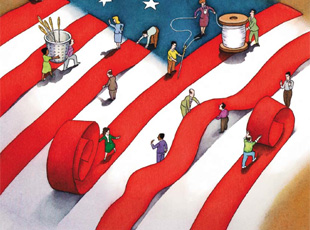Made in America, Again
Even today’s super-lean, robotized U.S. manufacturing base holds the promise of some good jobs. For one thing, the McKinsey report emphasizes, manufacturing and service-sector roles increasingly overlap.
 In the decade after World War II, the United States produced more goods than the rest of the world combined. Now America’s share of world production is about 20 percent, which, depending on how you count, is about the same as China’s or slightly more.
In the decade after World War II, the United States produced more goods than the rest of the world combined. Now America’s share of world production is about 20 percent, which, depending on how you count, is about the same as China’s or slightly more.
Most of this change reflects other countries’ rise rather than any American decline. In fact, U.S. manufacturing output is about six times higher than it was in 1950; American workers are nearly 10 times more productive than those in China. Moreover, as any country develops—even factory-dense China, even a champion industrial exporter like Germany or Japan—the share of manufacturing in its economy steadily shrinks, as the service activities that mark a richer society, from health care to education to travel, grow more rapidly.
But there is a trend worth worrying about, which is the disappearance of manufacturing jobs from the workforce. Shortly after World War II, about one-quarter of employed Americans held manufacturing jobs. Now less than one-tenth do. From the perspective of individual businesses, this change is natural and desirable—rising productivity by definition means fewer people making more things. But it is troublesome for society as a whole, since factory jobs have historically buoyed the middle class and given rise to future industries and jobs, virtuous-cycle style.
As I’ve visited scores of factories in the U.S., China, and elsewhere, I have asked experts about trends shaping the creation or elimination of manufacturing jobs. Those I’ll mention here are James Manyika, a director of the McKinsey Global Institute and a leader of a major study there on the future of manufacturing; Liam Casey, whose PCH International developed a vast outsourcing network in China and is now fostering hardware start-ups in the U.S.; David Joyce, the head of GE Aviation, which has opened six new engine-building factories in the U.S. in the past seven years; and Jeffrey Chidester of the University of Virginia’s Miller Center, which recently issued a report about U.S. manufacturing policies. (I was on a related advisory commission.) As with any important topic, the complexities are enormous, and the full reports are worth your time. But here, in shorthand, are three big things that could shape the future of manufacturing work in America.
Manufacturing may become strangely less international.
Yes, globalization continues: more than 5 million people work in the U.S. for foreign-owned firms, about one-third of them in manufacturing. And U.S. companies large and small are expanding their export ambitions. GE’s U.S.-based engine factories already send 55 percent of their output abroad and expect to send 75 percent within five years. “Our goal is: make it here, sell it there, and service it everywhere,” GE’s Joyce said.
Despite all this—and despite everything we’ve heard through the decades about companies offshoring their factories in search of ever-cheaper pay—high-value manufacturing may increasingly be within each nation’s ability to control. McKinsey’s report divides manufacturing activities into five categories, including minimum-wage sweatshop work at one end and highly precise and mechanized aerospace or medical-tech production at the other. Of these, McKinsey forecasts, the categories that will grow fastest, and pay best, will largely be those whose producers and customers are located in the same country rather than separated by long ocean-freight journeys or expensive air trips.
This is partly because some global supply chains have been stretched too far, leaving companies vulnerable to supply disruptions or quality problems on the other side of the world. But mainly, according to Liam Casey, it is because of the obvious reality that the more valuable the product, the less it matters that it be made with low-cost labor. “It’s more important that producer and customer are close to each other,” Casey told me. That gives designers a better sense of a market’s taste and a shorter cycle for creating new products. “Mass production will stay in China—for now,” he said. But start-up hardware firms will find it economical to do more of their work inside the United States.
New middle-class jobs might not be an oxymoron after all.
Even today’s super-lean, robotized U.S. manufacturing base holds the promise of some good jobs. For one thing, the McKinsey report emphasizes, manufacturing and service-sector roles increasingly overlap. Big industrial firms hire lots of designers, software engineers, accountants, and other service professionals. Architecture firms and design companies need their own 3‑D printers (and people to maintain them) and advanced-materials workshops. Across the board, McKinsey concludes, we should expect to see more of the kind of jobs that could help offset the winner-take-all pressures that have distorted America’s income distribution. Such positions aren’t likely to require the graduate-school credentials of the professional world, but they will pay much more than standard retail or food-service work—I have seen $17–$20 starting hourly wages at new factories in Mississippi and South Carolina.
“The automotive industry, for example, will need workers skilled in ‘me-chem-tronics’—an understanding of mechanical, chemical, and electronic systems—to support development of hybrid and all-electric power trains,” the McKinsey report says. It adds that America could soon face a shortage of workers in three middle-class categories: technicians of all varieties, workers in skilled trades, and engineers. If we know anything about our economy, it is that such shortages solve themselves, as wages rise and draw more people to a field.
Today’s arguments over taxes and regulation will bore tomorrow’s job creators.
Political discussions about boosting American industry typically stall on predictable arguments about tax rates or regulation. Of course everyone wants lower taxes. But in my interviews with entrepreneurs and industrialists, these familiar, divisive issues barely came up.
When Liam Casey took me through his Highway1 incubator for hardware start-ups in San Francisco, I spoke with 10 (mainly) young entrepreneurs who each hoped to set up a small hardware company somewhere in the United States. Not one of them volunteered tax or regulatory concerns as playing big parts in his or her go/no-go decisions. What they did want was a streamlined system to get their products into customers’ hands. To that end, they were concerned with things like the structure of retail distribution, especially the huge investment in inventory required to get their products carried in big-box stores. “Boring-seeming practical details make a big difference for these start-ups,” James Manyika told me. “If I am a small manufacturer doing something interesting, my chances are much better if I happen to be in physical proximity to a larger company, or to a network of experienced people who can help me get to scale.”
The list of ingredients that GE’s David Joyce sees as favorable to advanced manufacturing begins with a different kind of proximity: he wants each factory to be near both a research university and, ideally, a community college that can prepare people for high-skill, high-wage work. In our travels around the country for our American Futures project, my wife and I have seen many examples of community colleges and even high schools working with industries to equip students for well-paid technical jobs.
The Miller Center report, “Building a Nation of Makers,” is mainly about practical steps that might let start-ups and small companies take advantage of global trends. For instance, mapping now-opaque manufacturing supply chains could help connect smaller companies with potential customers. Because they are so practical, ideas like these don’t figure into normal political debate. But their very practicality increases their chances of paying off.
Anyone can list the environmental, fiscal, and political obstacles facing the American economy in general and its manufacturers in particular. And yet everyone I spoke with for this article emphasized the opportunities created by many of those same trends. Take environmental challenges: the “green economy” may once have seemed overbilled, but according to McKinsey, energy-saving technologies and a “circular economy” based on recycling are about to become real business opportunities.
“The idea that we don’t make things in America?,” David Joyce said. “Frankly, that is bullshit.”
Source: theatlantic.com

 News, training, experts opinion, bibliography, software and everything about Lean world.
News, training, experts opinion, bibliography, software and everything about Lean world.
